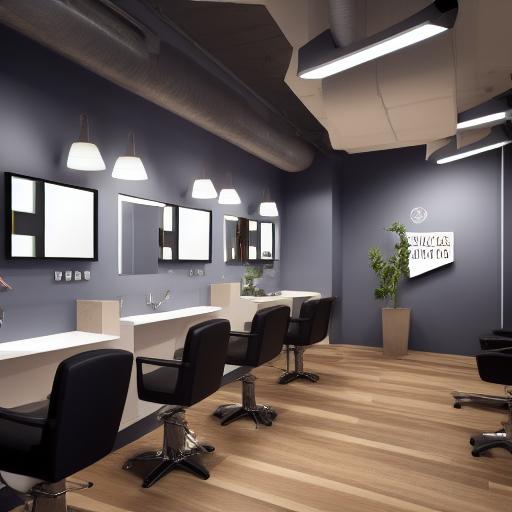
Choosing the right location for your salon is arguably the most crucial decision you’ll make. A poorly chosen location can cripple your business, even if you offer the best services and have the most skilled stylists. Conversely, a strategic location can significantly boost your success, attracting a steady stream of clients and setting you up for long-term growth. This comprehensive guide will delve into five key factors to help you make an informed decision and find the perfect spot for your dream salon.
1. Demographics and Target Market: Knowing Your Ideal Client
Before even looking at properties, you need a crystal-clear understanding of your target market. Who are your ideal clients? Are they young professionals, families, retirees, or a mix? What are their income levels, lifestyles, and spending habits? Understanding your target demographic will guide your location selection process.
1.1: Market Research – Beyond the Obvious
Don’t rely solely on gut feeling. Conduct thorough market research. This includes:
- Census Data: Utilize free resources like the U.S. Census Bureau (or your country’s equivalent) to analyze population density, age distribution, income levels, and household sizes within potential areas. Look for data on specific neighborhoods or zip codes.
- Competitor Analysis: Identify existing salons in your target area. What services do they offer? What are their price points? What is their clientele like? This helps you understand the existing market saturation and identify potential niches.
- Foot Traffic Analysis: Spend time observing potential locations during peak hours. How many people are passing by? What is their age range? Are they dressed in a way that suggests they might be your target client?
- Online Research: Use tools like Google Maps and Yelp to review local businesses and understand customer reviews and ratings.
1.2: Defining Your Ideal Client Profile
Create a detailed client profile. Consider factors like:
- Age: Are you targeting millennials, Gen X, or Baby Boomers?
- Income: What is the average income level of your target client?
- Lifestyle: What are their hobbies and interests?
- Spending Habits: How much are they willing to spend on salon services?
This profile will act as a compass, guiding you towards locations that are most likely to attract your ideal clients.
Example: If you’re targeting affluent professionals, you’ll likely want to focus on locations near upscale residential areas, corporate offices, or high-end shopping centers. Conversely, if you’re aiming for a more budget-friendly salon, you might consider locations near residential areas with a higher density of families or young adults.
2. Accessibility and Visibility: Making Your Salon Easy to Find
A salon’s location needs to be easily accessible to your target clients. Consider these aspects:
2.1: Parking and Public Transportation
Sufficient parking is crucial. If parking is scarce or expensive, it can deter potential clients. Assess the availability of free parking, paid parking, and public transportation options. Consider the convenience for clients who may be driving, taking public transport, or walking.
2.2: Visibility and Signage
Your salon needs to be easily visible from the street. Consider these points:
- Street-facing location: A street-facing location with large windows allows potential clients to see inside and assess the ambiance.
- Clear signage: Ensure your salon’s signage is prominent, well-lit, and easy to read from a distance.
- High foot traffic area: Locations with high foot traffic increase the likelihood of attracting walk-in clients.
2.3: Accessibility for Disabled Clients
Ensure your salon is fully accessible to clients with disabilities, complying with all relevant accessibility regulations. This demonstrates inclusivity and caters to a wider range of clients.
Example: A salon located in a bustling shopping mall with ample parking and clear signage would be significantly more accessible than a salon tucked away in a quiet residential street with limited parking and poor visibility.
3. Lease Terms and Costs: Understanding Your Financial Obligations
The financial aspects of leasing a salon space are critical. Carefully analyze the lease terms and costs to ensure they are sustainable for your business.
3.1: Lease Agreements: Read the Fine Print
Thoroughly review the lease agreement before signing. Pay attention to:
- Lease length: How long is the lease? Consider your business’s projected growth and expansion plans.
- Rent amount: Is the rent affordable and aligns with your budget? Consider both the base rent and any additional costs like property taxes and maintenance fees.
- Renewal options: What are the terms for renewing the lease at the end of the term?
- Permitted uses: Does the lease allow you to operate a salon specifically?
- Subletting clauses: Are you allowed to sublet any portion of the space?
3.2: Hidden Costs:
Be prepared for unexpected costs beyond the base rent. These might include:
- Utilities: Electricity, water, gas, and heating costs.
- Insurance: Property insurance, liability insurance, and other necessary coverages.
- Renovations and improvements: Costs associated with renovating the space to meet your salon’s needs.
- Maintenance: Ongoing maintenance and repair costs.
3.3: Negotiating the Lease:
Don’t be afraid to negotiate the lease terms. You might be able to negotiate a lower rent, a shorter lease term, or more favorable conditions.
Example: Compare several lease options and create a detailed budget that incorporates all potential costs to ensure you have a clear financial picture before making a commitment.
4. Competition and Complementary Businesses: Understanding the Local Landscape
Analyzing the competitive landscape and the presence of complementary businesses is vital for success.
4.1: Competitive Analysis: Identifying Your Strengths
Identify your competitors. What are their strengths and weaknesses? How can you differentiate your salon to attract clients? Consider offering unique services, specializing in a niche market, or creating a distinctive brand identity.
4.2: Complementary Businesses: Synergistic Partnerships
Look for businesses that complement your salon services. A salon located near a spa, gym, or boutique clothing store might benefit from synergistic partnerships and cross-promotion opportunities. This can increase your visibility and attract a broader client base.
Example: A salon located near a bridal boutique could offer wedding hair styling services, creating a mutually beneficial relationship. Conversely, a salon located next to a competitor offering identical services might face a more challenging business environment.
5. Local Regulations and Zoning: Navigating the Legal Landscape
Understanding local regulations and zoning laws is essential before securing a salon location.
5.1: Zoning Regulations:
Ensure the chosen location is zoned for commercial use and specifically allows for salon operations. Contact your local planning department to verify zoning compliance.
5.2: Permits and Licenses:
Obtain all necessary permits and licenses to operate a salon legally. These may include business licenses, health permits, and occupational licenses for stylists. Research the specific requirements in your area.
5.3: Health and Safety Regulations:
Comply with all health and safety regulations, including sanitation standards, waste disposal procedures, and fire safety regulations.
Example: Failure to obtain necessary permits or comply with health and safety regulations can result in hefty fines or even business closure.
Learn Business: Your Partner in Salon Success
Choosing the right salon location is a critical decision. To assist you in navigating the complexities of business planning and operations, we recommend exploring resources like Learn Business (https://learn-business.org). Learn Business offers valuable guidance and templates covering various aspects of business management, including detailed business plans, financial projections, marketing strategies, and much more. Their resources can help you create a comprehensive business plan, ensuring your salon is set up for success from day one. They provide templates tailored specifically to the needs of various businesses, including salons, making the process of planning and executing your business strategy far more streamlined and effective. Utilizing their tools can significantly enhance your understanding of the factors discussed in this article and ultimately contribute to making the right choice for your salon location.
By carefully considering these five factors and utilizing resources like Learn Business, you can significantly increase your chances of finding the ideal location for your salon and setting the stage for long-term growth and prosperity. Remember that thorough research, meticulous planning, and a deep understanding of your target market are your key ingredients for success. Don’t rush this decision; the right location can be the foundation of your thriving business.


Leave a Reply